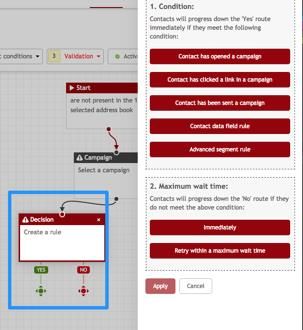In the first part we looked at setting up a landing page for use in a campaign – what a landing page is and what it should do. If you haven’t checked it out yet it’s worth a read. Promise.
Once we have our landing page set up we then want to consider what we do with a visitor's details once we have them. For instance, when we’ve created a registration landing page for, say, an upcoming webinar we need to devise an entire marketing programme around that. One of the important elements in that is marketing automation.
Automating it
Time was marketing automation was the preserve of large, enterprise CRM systems like Salesforce Pardot but increasingly it’s being integrated into marketing products the rest of us mortals might be familiar with – like Mailchimp and our own T4Mailer. Marketing automation is not necessarily just one thing – there are tools that automate metrics and lead generation – but here we’re going to look specifically at mail campaign marketing automation.
Just as in the case of our landing page template, the marketing automation program we create is reusable so most of the work is done at set-up, and from there it’s just a matter of re-using, tweaking and iterating. That’s not to say that it’s a cure-all or should be considered a lazy alternative to creating a quality campaign – content, remember, is still king and relevant content is even more important than a King (if we use a chess analogy then it would be the Queen) so there’s still a lot of work that needs to be done at the outset and during the campaign.
In the case of mail campaign marketing automation, we can devise a program – basically a set of conditions – that the marketing automation software will look to perform actions based on whether those conditions are true or not. It’s really just a decision tree that you can make as detailed as you want.
This is what we call Responsive Marketing – letting a campaign adapt to the interactions of your visitors.

Get with the program
Here’s a scenario – we’ve sent a mail to a recipient who has confirmed their attendance at a webinar. We want a reminder mail to send them a reminder mail the day before the webinar and perhaps an hour before too.
We could try to remember to do this ourselves or we could set up separate mail campaigns but instead, we can create a program that looks out for the date and sends the mail. This uses the same kind of conditional logic coders use when writing software but thankfully we just have to drag boxes around rather than worrying about curly braces or missing semi-colons.
We can check to see if a condition has been met – it could be a specific date, it could be a time interval after a signup or it could check whether a mail was opened or if the recipient has clicked on a link in the mail – and then do something based on that.
So now our scenario gets slightly more complex as it checks if the recipient has opened the mail or not – maybe there was an extra confirmation link they need to click before the registration is confirmed? Using marketing automation we can check that mail has been opened and if not send a reminder maybe a day or so later.
It’s important to remember that the details a potential client/customer has volunteered should be handled with care. It would be too easy to just turn your quality campaign into a loathsome spambot that serves no purpose other than to infuriate your recipients who eventually will unsubscribe and blacklist you from their lives forever.
The key is to ensure that every interaction is meaningful and relevant; if it’s not then chances are you’ve lost a potential customer
We can also use A/B Testing to present, say half the recipients, with one style of mail content and the other half with a slightly different version. This way you get to test them concurrently and tweak your mails depending on the outcome of one version.
Keep it simple
Although we can devise programs head spinningly complex and intricate it’s better for your own sanity and others who may have to work on it that you keep it relatively simple. It also avoids potential problems with emails going to the wrong recipient because of an issue in the program.
Marketing automation lets us set up a mail campaign – all campaign content and logic – at the beginning and works its magic over the course of weeks or months as we focus on other things or tweak campaign content over its lifespan. If something isn’t working then we can modify the campaign content to improve conversions and/or engagement.
Putting it all together
As with any campaign, it’s crucial to have measurable outcomes to judge performance against, otherwise, you may find you’re trying something for the sake of it. Want to increase conversions by a specific percentage? Want to have a specific amount of sign-ups in a week? With goals in mind, it’s easy to see what’s working and when it’s time to change tack.
The beauty of digital is that it’s never done – armed with metrics we can test and iterate on an ongoing basis and creating a reusable template for a landing page and marketing automation program means that we don’t have to reinvent the wheel every single time a new campaign is planned but can create meaningful and responsive engagements with customers and potential customers alike.

:format()//media/best-ways-to-hook-students-with-landing-pages-part-II-RQ.png)